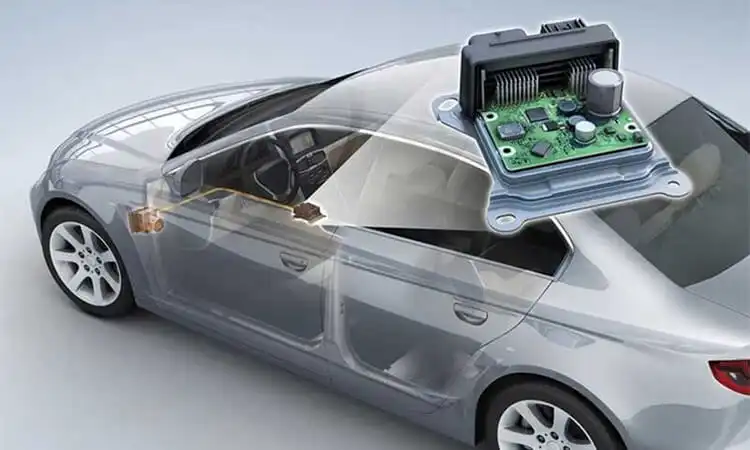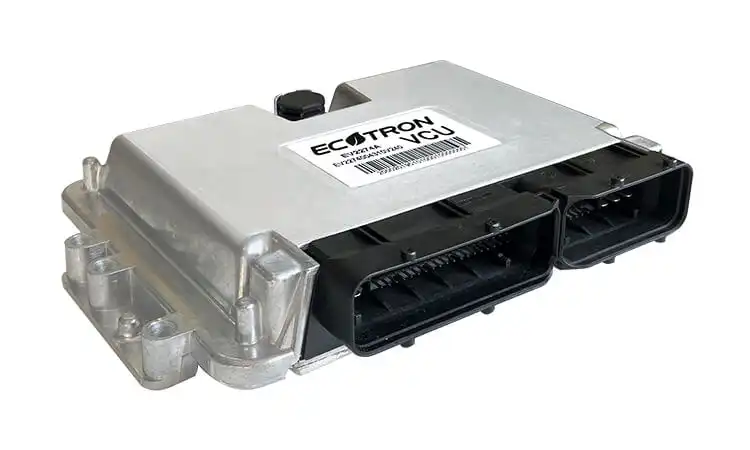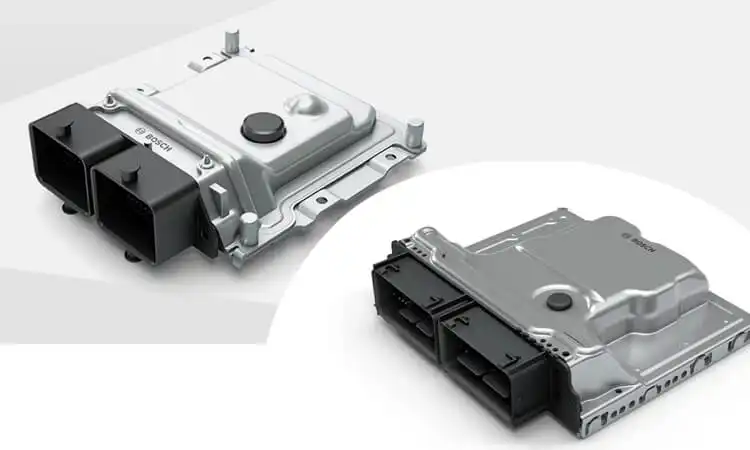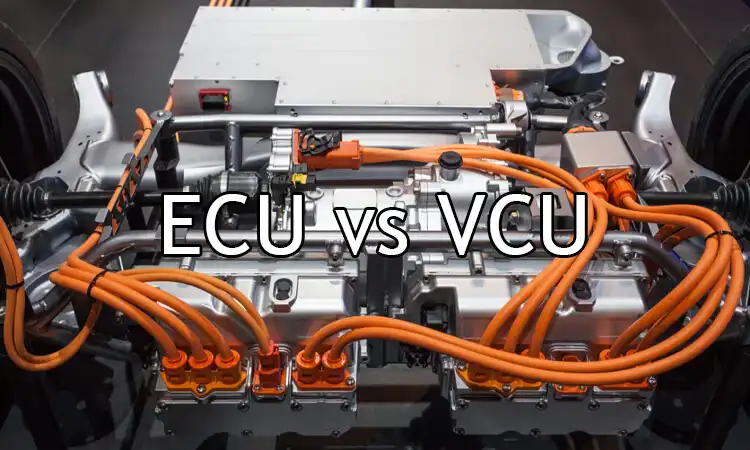Our vehicles have become more complex as we continue to rely more on technology. The Electronic Control Unit (ECU) and Vehicle Control Unit (VCU) are two essential components that help ensure our cars run smoothly. Understanding the differences between ECU and VCU is crucial for anyone looking to maintain, repair, or upgrade their vehicle. This blog post will explore the functions, types, and examples of ECUs and VCUs and highlight their advantages and disadvantages. So, let’s dive into the details and learn more about the difference between VCU and ECU.
What is ECU (Electronic Control Unit)
The Electronic Control Unit (ECU) is a microcomputer controller designed specifically for automobiles. It is often referred to as a “travel computer” or “vehicle computer.” The ECU operates in the same way as an ordinary computer, consisting of:
- A microprocessor (CPU) – the brain of the ECU. It is responsible for executing instructions and controlling the engine’s performance.
- Memory (ROM, RAM) – stores data and programming instructions that the CPU uses to control the engine’s performance.
- The input/output interface (I/O), analog-to-digital converter (A/D), and large-scale integrated circuits (ICs). They are responsible for receiving signals from various sensors and controlling the engine’s output accordingly.

The ECU’s main function is to control the engine’s air-fuel ratio and ignition timing. It does so based on real-time feedback from many sensors connected to the engine. This complex control requires data from various sensors to ensure optimal system performance. The vehicle’s ground speed is an important factor in determining the amount of power required from the engine and the optimal gear selection for the transmission.
Several factors influence the amount of fuel and air delivered to the engine. These factors include the engine speed, crankshaft position, air quality, and engine temperature. Understanding these variables is essential for optimizing engine performance and fuel efficiency. Additionally, engine load, throttle position and change rate, and transmission gear affect the timing of the ignition. These factors collectively impact the overall performance and fuel efficiency of the engine. The ECU must also track exhaust emissions to ensure the engine runs efficiently and meets emissions standards.
Understanding the Design and Function of Electronic Control Units (ECUs)
The ECU is designed to operate within a voltage range of 6.5-16V and has a voltage-stabilizing device in key internal parts. The ECU’s working current ranges from 0.015-0.1A, and it can withstand vibrations below 1000 Hz, making it highly durable.
The CPU is the ECU’s core component. It is responsible for performing complex calculations and control functions. During engine operation, the CPU collects data from various sensors. The CPU then processes these signals to transform the results. The transformed data sends control signals to regulate the controlled object’s performance. Additionally, the CPU manages memory (ROM/FLASH/EEPROM, RAM), input/output interface (I/O), and other external circuits.
The program stored in the memory ROM is based on precise calculations and extensive experimentation. This inherent program continuously compares and calculates the collected sensor signals during engine operation. The results of comparisons and calculations are used to regulate various engine parameters. These parameters include ignition, air-fuel ratio, idle speed, and exhaust gas recirculation. The regulation of these parameters helps to optimize engine performance and efficiency.
The Role of Electronic Control Units (ECUs) in Modern Vehicles
In modern vehicles, Electronic Control Units (ECUs) are not only used in engines but also found in various other systems. For example, in an anti-lock braking system, the ECU controls the brakes’ hydraulic pressure to prevent the wheels from locking up during braking. Similarly, in an electronically controlled automatic transmission, the ECU controls the shift points and the torque converter’s lock-up clutch to optimize performance and efficiency.
As electronic automation in vehicles continues to improve, ECUs are becoming increasingly prevalent, and the circuits are becoming more complex. Information transmission between many ECUs must adopt a multiplex communication network technology to simplify the circuits and reduce costs. This technology forms a network system of the entire car’s ECUs, known as the Controller Area Network (CAN) data bus.
What is VCU (Vehicle Control Unit)?
The Vehicle Control Unit (VCU) is a critical component found exclusively in electric vehicles. The VCU is the electronic control unit responsible for managing the vehicle’s power and battery systems. It is often called the “travel computer” of electric vehicles. In contrast, traditional fuel vehicles use the Electronic Control Unit (ECU) for this purpose.

The VCU collects data from various sensors to determine the driver’s intentions, including the accelerator pedal, gear position, brake pedal, and vehicle state (speed, temperature, etc.). It then processes this data to send control instructions to the vehicle’s power and battery systems. The VCU also controls the onboard accessory power system. This system includes functions such as air conditioning, heating, and entertainment systems, making the VCU a central component in the overall vehicle control system.
One of the essential functions of the VCU is to manage the vehicle’s energy efficiency. The VCU can optimize the power and battery systems to ensure that energy is used efficiently and that the vehicle can travel the maximum distance possible on a single charge. Additionally, the VCU can manage the charging and discharging cycles of the vehicle’s battery to extend its life and prevent damage.
The VCU also includes fault diagnosis, protection, and system storage functions. It can detect and diagnose issues with the vehicle’s systems, offer protection against overcharging and over-discharging of the battery, and store data on the vehicle’s performance and usage.
As electric vehicles continue to evolve, the VCU is becoming increasingly sophisticated and capable. The VCU has advanced capabilities that are continually evolving with advancements in technology. For example, with the introduction of artificial intelligence and machine learning, the VCU can learn from the driver’s behavior. This learning allows the VCU to adjust the vehicle’s performance to suit the driver’s preferences and driving style.
Advantages and Disadvantages of ECU vs. VCU
Here are some advantages and disadvantages of the Electronic Control Unit (ECU) and the Vehicle Control Unit (VCU):
Advantages of Electronic Control Unit (ECU):
- Efficient Engine Performance: The ECU manages the engine’s performance and emissions, which can improve fuel efficiency and reduce emissions.
- Wide Availability: The ECU is widely available and used in most traditional fuel vehicles, making it easier to repair and find replacement parts.
- Cost-effective: The ECU is a relatively simple device, which makes it cost-effective to manufacture and maintain.
Disadvantages of ECU:
- Limited Functionality: The ECU is only responsible for managing the engine’s performance and emissions. It does not have the advanced capabilities found in the VCU, which is used in electric and hybrid vehicles.
- Limited Compatibility: The ECU is only compatible with traditional fuel vehicles. It cannot be used in electric vehicles requiring a specialized VCU instead.
- Limited Data Processing: The ECU has limited data processing capabilities. Therefore, it cannot handle the large amounts of data required in modern vehicles.
Advantages of Vehicle Control Unit (VCU):
- Improved Energy Efficiency: The VCU optimizes the power and battery systems to maximize energy efficiency. This optimization can result in a longer driving range and improved performance of electric and hybrid vehicles.
- Advanced Capabilities: The VCU has advanced capabilities such as battery management, thermal management, and regenerative braking. These capabilities enhance the performance and energy efficiency of electric and hybrid vehicles.
- Future Compatibility: The VCU is compatible with electric and hybrid vehicles. This compatibility makes it a more versatile and future-proof option.
Disadvantages of VCU:
- Higher Cost: The VCU is a more complex device than the ECU, which makes it more expensive to manufacture and maintain.
- Limited Availability: The VCU is only found in electric and hybrid vehicles. This exclusivity limits its availability, making repairing and finding replacement parts more challenging. As a result, VCU repairs and replacements may require specialized knowledge and expertise.
- Complexity: The VCU is a more complex device than the ECU, which makes it more challenging to diagnose and repair if something goes wrong.
ECU vs VCU: Difference between ECU and VCU
The ECU and VCU are both types of electronic control units used in vehicles. While they share some similarities, there are also several key differences between them.

Vehicle Type
The most significant difference between ECU and VCU is the type of vehicle they are used in. The ECU is typically used in traditional fuel vehicles, while the VCU is used in electric vehicles. This is because electric vehicles have different power and battery systems that require specialized control.
Control Function
Another key difference between ECU and VCU is their control function. The ECU manages the engine’s performance and emissions, while the VCU manages the vehicle’s power and battery systems. The ECU is responsible for controlling the fuel injection, ignition timing, and other engine-related functions. On the other hand, the VCU is responsible for controlling the electric motor, battery charging and discharging, and energy regeneration.
Sensor Inputs
The sensor inputs for both units are different because they have different functions. The ECU receives inputs from sensors such as the throttle position sensor, oxygen sensor, and crankshaft position sensor. In contrast, the VCU receives inputs from various sensors. These sensors include the accelerator pedal, gear position, brake pedal, battery voltage, and temperature sensors.
Power System Management
The VCU is responsible for managing the vehicle’s power and battery systems, including battery charging and discharging, energy regeneration, and thermal management. The ECU does not have this function. This is because traditional fuel vehicles do not have a separate power and battery system, as found in electric vehicles.
Energy Efficiency
The VCU plays a critical role in improving energy efficiency in electric vehicles. It optimizes the power and battery systems to maximize the vehicle’s range on a single charge. Additionally, it manages the battery charging and discharging cycles to extend its life. Furthermore, it recovers energy during braking, which helps reduce energy consumption. The ECU does not have these functions because it manages the engine’s performance and emissions, which are not directly related to energy efficiency.
In summary, the ECU and VCU are two types of electronic control units used in vehicles, with different functions and sensor inputs. The ECU manages the engine’s performance and emissions, while the VCU manages the vehicle’s power and battery systems. The VCU plays a significant role in improving energy efficiency in electric vehicles, while the ECU does not have this function.
Related Articles:








